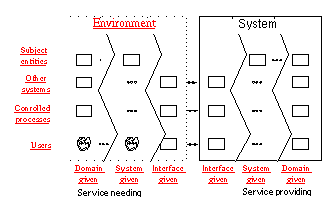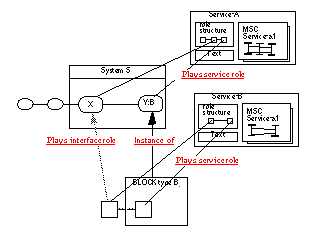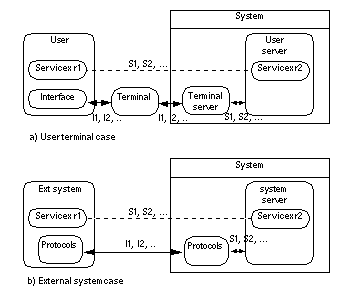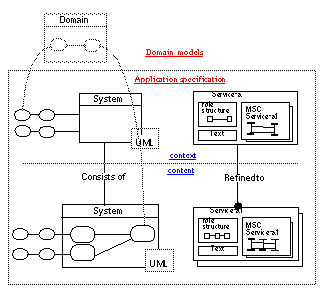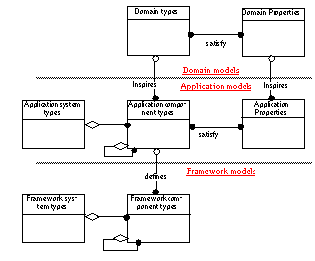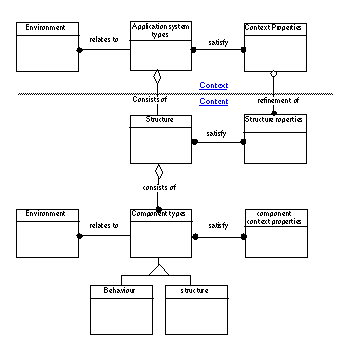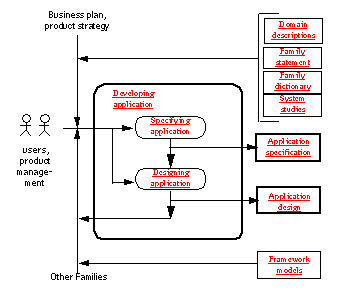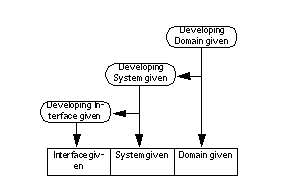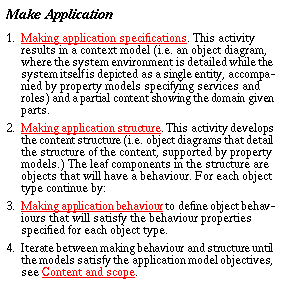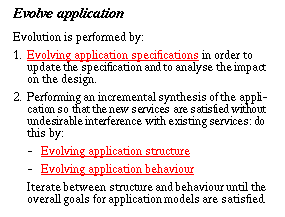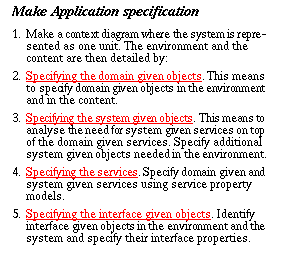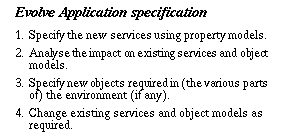Application reference model
It is abstract
The application is an abstract system which provides the services that users and other systems in the environment need. It determines the quality of the system services.
As an open systems it exists in a
context
where it attain purpose and meaning from an environment. This context may again be part of an even wider context, such as an enterprise, where the system and its environment together serve some higher purposes.
The
domain
is a generalisation of this wider (enterprise) context. In contrast to the domain, the system context is a part of the world being served by a system. The domain is a more general and often wider area of concern.
In the reference model for application systems we consider the system and its environment, see
Figure 21. Both the system and the environment are decomposed into
Domain given,
System given
and
Interface given
parts:
-
Figure 21: Application system reference model
-
Open figure
-
Domain given
parts provide functionality which is common to most systems in a
domain.
-
System given
parts provide functionality which is specific to a particular system or system family.
-
Interface given
parts take care of the communication between the service needing parts of the environment and the service providing parts of the system, see
Figure 21.
These parts may have quite different characteristics and contribute to the overall functionality in different ways. Note that the services are related to the domain given and the system given parts, while the interface given parts only serve as communication media. Interfaces have been separated from services in order to achieve protocol transparency and modularity. It is generally desirable that services can work over a range of communication facilities and that interfaces and services can evolve as independently as possible.
The
Environment
is further decomposed into:
-
Subject entities: entities known by the system, but not directly interacting with it. The Access Zones handled by the Access Control system is one example. The materials and products handled by a MPS system is another.
-
Other systems: other systems communicating with the system. In the case of an ATM machine, this would be the central bank computers.
-
Controlled processes: equipment being directly controlled by the system. The Doors controlled by the Access Control system is a simple example. More complex examples are the mechanical parts of a paper mill or a robot.
-
Users: human beings communicating with the system. In this category we have end-users as well as operation and maintenance staff.
Since the system shall serve the environment, we will find corresponding entities within the system. In fact, TIMe recommends to "mirror" the environment by objects inside the system. Some of these will be
active object
and some will be
passive objects, see
Object Models. The active objects provide services, while the passive represent entities and relationships the system needs to know.
The application system reference model has been inspired by the OOA&D method (Mathiassen et al. 1993), but adopted and detailed to suit reactive real-time systems. Methods like object modelling with UML do not have this kind of system reference model.
We believe the reference model will help to structure system models and to give more precise method guideance.
System context
What
A system
context
is a part of the world containing the system itself and its
Environment. Thus,
Figure 21
illustrates a system context.
Symmetry
Note that:
-
there is symmetry between the environment and the system: objects in the environment are served-by and represented-by objects in the system;
-
there is symmetry of interfaces around communication links served by protocol stacks. Sometimes the system boundary coincides with such links and sometimes not.
Domain given
What
Parts that are modelled in the domain and therefore common to most systems in a domain are classified as domain given parts. The domain given parts of the environment contain domain entities that are served by the system, typically
actors
and processes, and
subject entities
known by the system. The domain given parts of the system itself contain domain entities that are realised by the system, typically some domain
Helpers. They also contain passive objects representing domain given entities of the environment.
Example
The users and the Access Zones of the Access Control system are examples.
Explanation
Domain services will be quite general and common to most systems in a given domain. Every PBX, for instance, is able to provide normal two-party telephone calls. Any access control system will know about users and access rights. Such parts are likely to be stable and may potentially be reused in many systems and system families. This is one reason to separate these parts from the more system specific parts.
In methods like object modelling in UML or OOA&D the emphasis is on passive objects representing knowledge about phenomena in the problem domain. In our method, we also include active objects that perform services.
System given
What
The system given parts are specific to a particular system or system family. They will act together with domain given parts to provide the services.
Example
In the Access Control system the operators and the objects serving the operators is an example. Another example is the error handling and initialisation functionality needed in most systems.
Explanation
These parts provide the services that makes this particular system, or system family, different from other systems in the problem domain. The
System given
parts can collaborate with the
Domain given
parts of the system to accomplish the services. They are separated from the
Domain given
parts because they are less stable, general and reusable. The purpose of these parts may be to:
-
Perform solution dependent services, i.e. services that depend on the actual system design. Error handling and maintenance services are typical examples.
-
Attend to special needs, not solved by other systems in the domain, i.e. to provide some positioning properties.
Interface given
What
The interface given parts take care of the communication between the service needing parts in the environment and the service providing parts in the system.
Explanation
Communication require interfaces. In some cases the interface is simple: just hit a button. In other cases it involves complex behaviour, such as protocols and graphic user interfaces. In most cases there is independence between the interfaces and the service provided through the interfaces. It is therefore recommended to isolate what is specific to an interface from the services provided over it. This is particularly true where there is a complex behaviour associated with the interface.
Such separation allows interfaces and services to evolve independently and help to protect investment in either area from changes in the other.
Parts
The interface specific parts are subdivided into:
-
User Interfaces. Parts taking care of Human Machine Interaction (HMI). These parts are often critical for the user satisfaction, and hence the success of a product. User Interface design is an area that require careful attention and specialist knowledge. It will sometimes involve prototype building and experiments. It will therefore often be a separate development task involving other people than the other parts of the system.
-
Process Interfaces. These take care of the interfaces to controlled processes. They will involve sensors and actuators as well as interface electronics and software drivers. This part will often require understanding of the technological principle of the controlled processes, actuators and sensors. It is therefore a multidisciplinary area, involving several technologies. It is an area where real-time constraints are important and need careful consideration.
-
Other System Interfaces. These take care of communication with other systems. They involve the necessary hardware, the software drivers, and the protocol stacks. Sometimes they will involve standard networking technology. In other cases special solutions are needed.
Layering
Common to all these parts is the Layering Principle. All interfaces will be layer structured, starting with the physical medium moving upwards to the services in the
System given
and
Interface given parts of the system.
Example
In the AC system we have a user interface with a physical layer: the Panel, and a protocol layer: PanelControl.
Environment
The environment consists of the parts of the surrounding world which are either known to the system or communicate with it.
Subject entities
What
Most systems will contain data representing entities, relationships and measures external to themselves. The actual entities, relationships and measures represented by such data are denoted collectively as known entities. The known entities can be seen as the meaning (semantics) of the data.
Subject entities
are known entities that a system does not interact with directly.
Example
A salary system, for instance, needs to know about employees, but will normally not interact with them, hence the employees are subject entities.
Subject entities will often be domain given.
Other systems
What
Other systems are external technical systems with which the system in question is communicating to accomplish its purpose.
Example
A PBX for instance, will communicate with nodes in the public telephone network. An ATM machine will communicate with the central bank computers.
Explanation
Many systems will communicate with external systems. In some cases the relationship will be asymmetric, as in a client server architecture. In other cases it will be symmetric as between the switching nodes in a communication network. Anyhow, the relationship with other systems may be central to the purpose of the system in question. Sometimes the system even receives its prime purpose from external systems.
Other systems are sometimes domain given and sometimes System given.
Controlled processes
What
The controlled processes are equipment in a surrounding technical system being directly controlled by the system in question.
Example
In the Access Control system, the Doors are controlled processes. In an ATM machine, the money-bin is a controlled process. In a lift control system, the physical hoist unit and the lift chair are controlled processes.
Explanation
Controlled processes will only be present in embedded systems, where the application system is controlling a larger technical system, e.g. a paper mill, a telephone exchange or a robot. Normally this larger technical system will rely on the application system to behave as required. This is typically the case in so-called mechatronic systems, where software, hardware and mechanical solutions are integrated. A mechatronic system will comprise active parts which exercise control and passive parts being controlled.
System boundary
It is a matter of definition where to put the system boundary, and hence what to consider as part of the system in question and what to consider as controlled by the system. If we consider a complete lift system, the physical hoist unit containing motors, brakes, wires, etc. will be considered as part of the system. If we consider only the lift control system, then these parts are considered as controlled by the system.
The controlled processes will often be domain given.
Users
What
Users is the term collectively used for human beings interacting with the system in question. They may play a variety of roles such as operators, service personnel or clients. domain
actors
supported by the system will be domain given, while others will be system given.
Application models
Application model overview
Objectives
First of all, application models serve three basic purposes:
-
To describe behaviour at an abstraction level where it can be understood and analyzed independently of a particular implementation.
-
To be a firm foundation for designing an optimal implementation.
-
To be source for automatic generation of implementation code.
The purpose of the application models in general is to answer what systems in the family shall do.
They should support unambiguous communication among project members and in-depth understanding by the individual. An application model is made primarily for human communication and analysis, not for machines. But it should also be processed by machines.
It should be readable for the human being without being vague or ambiguous and it should express the behaviour without unwanted bias towards the physical implementation in order to allow freedom in selecting the implementation.
At the same time it should be implementable so it can be trusted as documentation. In fact, we will generate code automatically from application models.
Once application models serve these purposes and we are able to actually engineer systems on the application level, some secondary purposes emerge. We want to further reduce lead times and to introduce new services more quickly than before. Therefore we want application models to be:
-
modular with respect to service description;
-
flexible with respect to service introduction.
To achieve all these objectives, application models should be structured with the following criteria in mind:
-
Clarity and simplicity of behavior interpretation by the human.
-
Modularity supporting incremental service evolution and isolation/encapsulation of change.
-
Coverage of the necessary variability.
-
Possibility for analysis by the machine.
-
Possibility for automatic code generation.
What
As illustrated in
Figure 22, the complete application system may be defined as a type. This will be a natural thing to do during the first time development. However, once a framework has been defined, the complete application system may become less important, because it is the component types and not the complete application system, that will be used in frameworks. Therefore the component types used to construct the application system may be more important than the system itself.
This observation is strengthened by the fact that it may be difficult to express all the variability needed formally in one type model. It may prove more practical to develop several component types that are easy to compose into alternative system types. Thus, the most important part of application models is a library of (component) types that can be used to define application systems using either composition or inheritance.
Application model content
Application specification and design parts
As all other family models, application models have two main parts:
the specification part
(see
Application specification) and
the design part
(see
Application design). Each part consists of object models and property models as illustrated in
Figure 22:
-
Figure 22: Application specification and design
-
Open figure
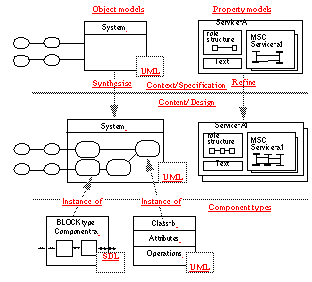
-
The
specification
focuses on the environment and how it relates to the entity being defined. In the object model, the entity itself is represented as a black box while the environment is detailed. Associated property models will focus on interactions between the entity and the environment. Every service it provides shall be described by means of roles, text and MSC.
-
The design focuses on the content. In the design object models we will see how the application system is composed from parts and also how these parts behave. In the property models we will see how design objects interact. It is of course, essential that the properties actually provided by the design objects correspond to those required in the specification. (A combination of property conserving synthesis and verification techniques is used to ensure that.) The object model design consists of two parts:
structure design which define the structure of objects and component aggregates;
behaviour design that define the behaviour of objects.
Application system boundary
What should be inside and what should be outside the system is a question that often causes high tempered and endless discussions. We contend that the decision is not very crucial, as the method we propose will allow the boundary to be adjusted later on with little effort.
The important thing is to include either in the environment or in the system itself everything the system ultimately will serve or know. In particular it is important to represent all the various stake-holders needing to be served or represented by the system. These should be placed in the environment. Other objects we are sure never will be produced or delivered as part of a system instance, e.g. people, should be put in the environment. This does not exclude the possibility of including some of these in the system at a later stage, for instance as part of a simulator.
Application services and objects
The services of a system are defined in application property models. As in the domain, the application service models contain a textual explanation, a role structure and an MSC document.
In general, an object is assigned properties in the following three ways, see
Figure 23:
-
Figure 23: Ways that services are related to objects
-
Open figure
-
By explicit assignment of service roles using the
Plays service role
relation. This is because the object is part of an object type to which we explicitly assign property models.
-
By implicit assignment of service roles from the object type it is an
instance of. This is because objects are instances of types that may have explicitly assigned roles.
-
By implicit assignment of
interface roles
required by objects in its environment. This is because the object appears in an environment where surrounding objects will expect the object to behave according to some interface.
Of course, all the roles that an object receives must somehow be consistent with each other and with the properties that the object actually provides.
Therefore, care must be taken to maintain consistency between the properties specified explicitly for the system as a whole and those received implicitly from its components and the environment.
Role sets
-
The set of roles explicitly assigned to an object should be a subset of those that follow implicitly from its type and its environment.
The application reference model parts
Domain given
Application models are closely related to the domain and the needs of domain stake holders. We are likely to find some of the domain
actors
in the system environment (those that the system will support), and some domain
helpers
inside the system (in the domain given part).
System given
A system family may have many features that were not covered in the domain models, e.g.:
-
positioning properties that help this family to be a winner in a competitive marketplace;
-
properties related to issues outside the domain such as operation and maintenance functions for the system as such.
We recommend to model the System given parts in the same general way as the domain given, except that the System given parts originate outside the domain and have no relations to domain models (except in cases where they lead to new understanding of the domain).
Interface given
It is recommended to distinguish between the service behaviour and the interface behaviour by using layering as illustrated in
Figure 24.
-
Figure 24: A service layer and an interface layer
-
Open figure
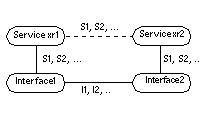
Further we recommend to first define the service behaviour separately without any reference to interface given parts. This means to consider only the two service roles xr1 and xr2 and their dashed interconnection in
Figure 24. When interfaces are introduced, the services shall ideally behave in the same way even though the interconnections go via the interfaces and the dashed interconnection in
Figure 24 disappears.
(It may happen that interfaces interact with the services in ways that were not anticipated in the service models, for instance that messages may be lost. In such cases the service behaviour must be modified to take the interaction into account.)
Figure 25 illustrates how services and service objects may relate to the interface given parts. Where to place interfaces in relation to the system boundary, and how to model them is often a difficult choice.
-
Figure 25: Two cases of interface given parts
-
Open figure
In the User terminal case, we have placed the
Terminal
in the environment and a
Terminal server
inside the system. Note that the
User
will play both a service role and an interface role in this case. Since these roles are internal to the User object, the service interactions S1, S2,. are not visible outside the User. Inside the system however, the roles are played by two different objects, and therefore the service interactions are visible there. In the
Ext system
case, the interface given parts are
Protocols
belonging to the two systems.
Application languages and notations
As illustrated in
Figure 22, the main languages to use are
MSC
for property models and
UML
combined with
SDL
for object models.
SDL is the main language for control behaviour, while UML will be used for other aspects (such as user interfaces and data-bases). Typically UML will be used in the specification part, and possibly for top level design structuring. SDL will take over where the main thing is to model reactive behaviour.
In some cases it will be possible to express the application object models completely in SDL.
For description of interaction properties, we stick to MSC even if UML is used for the Object Model.
Application specification languages and notations
Normally UML will be used for the specification object models:
Application specification notation
-
In general use UML for the specification object model:
Context: model the application system as a Class. Represent the environment as object sets with specified variability. Describe associations and communication links in the environment and with the system.
Content: model the content (if any) as object sets inside the class.
Component types: define a class for each component in the system environment and content. For each component class, model the context using separate diagrams.
For property models, text, role structures expressed in UML and MSC will be used.
Using SDL in application specifications
If SDL is used, we recommend to model the application system as an SDL Block type rather than as a System type. There are two main reasons for this:
-
It is possible to formally describe the environment of Block types but not of System types.
-
Block types can be used as components while System types cannot.
-
Where reactive behaviour is important and general relations (associations in UML) are unimportant, SDL should be used in the specification:
Context: model the application system as a Block Type in SDL. Represent the environment as gate constraints.
Content: model the content (if any) as Block sets.
Components: define a Block or process type for each component in the system or the environment. For each type, define the type context.
-
Associate the roles of property models with the objects and types/classes of object models.
Application design languages and notations
For reactive, state transition behaviour it is recommended to use SDL. This means that active objects in general should be described with SDL. One exception is graphical user interfaces. For passive objects, and especially objects going into a database, UML may be preferred.
This means that the application design may use a combination of SDL and UML.
Application design notation
-
If the specification uses SDL, then continue with pure SDL in design.
-
If the specification uses UML, then continue with UML for the structure until SDL components are reached.
-
Use SDL for components and subsystems having reactive, state transition behaviour.
Of course this division may cause interworking problems between the SDL and UML parts.
-
For property descriptions, we use role structures in UML, text and MSC.
Application specification
Objectives
An application specification serves to answer fundamental questions like:
-
What services are provided?
-
What is the environment i terms of
active
and
passive
objects?
-
3. What is variable in the environment and the services?
It specify the external interfaces and behaviour properties (services) of an application.
What
The application specification models are illustrated in
Figure 26
-
Figure 26: Application system specifications
-
Open figure
Specifications are developed first for the application system as a whole and later for each (component) type. We distinguish between domain given, System given and Interface given parts. It is natural to use this division as a guideline in the specification:
-
Domain given parts and services
. These originate in the domain models and may be used more or less directly in the specification. The specification shall describe which parts of the domain that are supported by the system. Some of these will be in the environment, and some inside the system, see
Figure 26. Domain given objects inside the system might as well be shown in the specification. For domain services, it may be possible to use the corresponding domain property model directly, but it is likely that some modifications will be needed. In any case the relationship to domain models shall be maintained, see
Application model relationships.
-
System given parts and services
. These may be special for the system family or they may be shared with other families. We recommend to focus on the environment, and avoid specifying content. The specification shall describe system given objects in the environment, and the system given services. We do not include System given objects inside the system in the specifications unless there are good reasons for it. But the services may well specify service roles that will be played by (as yet unknown) actors in the system.
-
Interface given parts and interface properties
. These are introduced to provide reliable communication across the system boundary for domain given and system given parts. As the interface given parts often coincide with the external system interfaces they are an important part of specifications. Therefore specifications may include interface objects both in the environment and the system. Layering should be applied to isolate the interfaces from the other parts.
Domain given types will be quite stable, and may be reused between many systems and system families. System given types are less stable as they provide the functionality that is particular for a system or system family. Among the interface given types, user interfaces can be the least stable. Protocols, on the other hand, may be quite stable.
Application specification content
Domain given specification
One key issue in any system development is to decide on what parts of a domain to support. (This is true even if there are no explicit domain models.) Basically this means to decide on which domain
actors
and which domain services to support. These shall be represented in the specification as follows:
Domain given specification
-
Every domain
actor
and
helper
needing to be served by the system shall be represented (as
active objects
) in the environment.
-
Every
stake holder
,
subject entity
and
helper
the system needs to know shall be represented (as
passive objects
) in the environment.
-
Every domain helper the system shall implement shall be represented in the (domain given) content.
-
Every domain relation(association) the system needs to know shall be represented in the environment.
-
Every domain communication link the system needs to handle shall be represented.
As a result we have a subset of the specification object model representing the domain given parts. Inside the system (in the content) we only find domain objects (Helpers) that are going to be
realized
by the system. In the environment we find the domain objects that are going to be
supported
(if they are active) or
represented
(if they are passive) by the system.
-
Every domain given object shall have a type (class) which is related to the corresponding domain type (class).
-
Each domain given service shall be described independently of interfaces using service roles.
-
Each domain given type shall have relations to the domain given service roles it participate in.
In this way there will be a separate service description (using role structures, text and MSC diagrams) for each domain given service. Interaction with System given service roles should be shown but interface given roles should be avoided.
System given specification
We do not include System given objects inside the system in the specifications unless there are good reasons for it. We recommend to focus on the environment, and avoid specifying content.
Again we recommend to separate services from interfaces.
In an enterprise view, consider stake holders and other entities that need to
interact
with
or be
represented by
the system.
System given specifications
-
Every entity that needs to interact with the system shall be represented in the system environment with a communication link to the system.
-
Every entity and relation the system needs to know shall be represented in the environment.
-
Each service shall be described independently of interfaces using service roles.
-
Each system given object in the environment shall have a type definition with relations to the system given service it takes part in.
As a result, we have a detailed description of the environment and the communication links with the system. Each service has a separate description, and we know which service roles that are going to be played by the system itself and by the objects in its environment.
Interface given specification
Specifications will often be quite detailed about interface given parts. Interface given parts will be localised somewhere on the communication links between the system and the environment where their role is to convey the service interactions.
Interfaces will often have a layered structure with one or more protocol layers on top of a physical layer.
Interface given specifications
Application design
Objective
To describe the design part of an application that:
-
satisfies the specification;
-
has clearly defined behaviour;
-
has a modular structure suitable for future evolution;
-
fits into the framework when defined.
What
The context part of an application is fully covered in the specification. The design part adds the content which is not covered in the specification. It defines the content
structure
in terms of objects, and the
behaviour
of each object type.
The first purpose of an application design model is to describe the system behaviour at an abstraction level, where it can be understood and analyzed independently of a particular implementation. This is done in terms of both an object and a property model.
The second purpose is to be a firm foundation for designing an optimum implementation satisfying both the functional and non-functional requirements.
Object behaviours are central to the application, and the design should primarily be structured to give clear and concise behaviour models. We contend that behaviour should be described state oriented, see
General application guidelines. To achieve that, the structure should contain one object for each independent (concurrent) thread of behaviour in the system. These objects may be then aggregated in various ways to suit additional purposes.
It is recommended to make a library of component types that can be used in a range of application systems to cover the full variability needed. Some of these will be real aggregates containing a structure of components, and others will be object types with behaviour. The component types designed with SDL will be organised in Packages. (Packages are used only for types that are general enough to qualify for being part of a package. It is, however, possible to start with collecting the types being used in a specific system in a set of packages.)
Application design content
Application design models consists of:
-
The application modeled as a structure type. It is a type definition with context and content that define the overall structure of the application system and may use several levels of real aggregation. It will be constructed using a collection of component types and refer to the definition of these component types for further detail. The content structuring is primarily concerned with active objects and interconnections. However, the active objects will contain passive objects and conceptual relations.
-
The component types which are either:
structure
types that consist of object aggregates, defining the content as a structure of components, or
behaviour types,
i.e. object types having a behaviour of their own, e.g. SDL processes. There will be both
active object
s and
passive objects
as well as association between active objects and passive objects, i.e. which active objects that access and may change the passive objects representing known entities in the context. (For SDL, the passive objects will be variables contained in processes)
-
3. Property models for the overall content. The application content shall satisfy the specified context properties.
Each type is defined with a context and a content with associated properties. An object type definition consists of:
-
the context in terms of active objects and passive objects in the environment;
-
the interfaces in terms of gates (or equivalent in UML);
-
behaviour properties in terms of service roles, interface roles and MSC;
-
attributes;
-
the behaviour definition in terms of SDL process graphs or UML operations.
Application model relationships
How the application is related to the domain and the Framework is illustrated in
Figure 27.
-
Figure 27: External Application relationships
-
Open figure
Relationships application - domain
We recommend that each domain given object has a type, with a context description. (Each of these types will correspond to one of the component types that we recommended to make in the
Domain object models) In this way the relations to the domain go via the types.
The nature of these relationship may vary from plain equality (when domain objects can be used as-is) through inheritance (when the application objects are extensions of the domain objects) to informal similarity (when the domain objects are just used as inspirations for the application objects).
Domain relationships can thus be either
Identity, Inheritance
or
Inspires
where
Identity
and
Inheritance
can be expressed in the object modelling languages, while
Inspires
must be added as annotations. In
Figure 27 we have only indicated the weakest relationship "inspires".
Ideally the domain given types should be identical to the domain types. Any difference shall be due to system given or interface given aspects. As far as possible we seek to isolate these aspects, but it cannot be avoided that the domain given objects are influenced:
-
Domain given objects will most likely interact with System given and Interface given objects. As this was not accounted for in the domain models, it is likely that the domain given objects will have additional features.
-
System given services will most likely interact with domain given services. These interactions must be resolved. This means that the domain given service behaviour must be
refined
to take these interactions into account, see
The dialectics of refinement
.
Consequently, the domain given behaviour properties will be a refinement of the corresponding domain properties.
Application domain relationship
Domain communication
-
If there are communication connections between objects in the domain object model, then there will be a corresponding communication between the design objects, possibly via some interface given object(s).
Harmonising application - domain
Only the domain given parts need to be considered. When these parts differ from the corresponding domain models, the difference should be caused by System or Interface given aspects. If they are not, it is likely that the difference is accidental and should be removed, either by changing the domain model or the application model. (It is not uncommon that working with the application helps to improve the understanding of the domain.)
Application domain harmonisation
-
Critically review the application looking for general aspects that are not system or interface specific. Update the domain models to capture these aspects.
Relationships application - framework
Frameworks are composed from an infrastructure part, that come from the implementation architecture, and a redefinable application part, that come from the application. Objects in the application part (of the framework) are formally related to Objects in the application by using the same types. However, the application part of the framework may be structured somewhat differently from the application. This means that the application types need to be designed so they can be distributed in the framework and communicate transparently with each other and the environment. It also means that they must be adapted to the operation and maintenance services provided in the framework, e.g. the methods for dynamic system configuration.
Application framework relationship
-
Every type used in the application part of frameworks shall be defined in the application models.
-
Every application type shall be applicable in the framework.
Harmonising application - framework
Application types are developed and maintained as part of the application, and used in frameworks to produce executable systems. It is not necessary to develop a complete application system each time a new executable system is to be produced. It is sufficient that the necessary (component) types are available for use in the framework. However, to fit into the framework, application types must comply with the framework infrastructure and interfaces.
Application framework harmonisation
-
When the framework is defined, adjust all application types to comply with the framework infrastructure and interfaces.
-
Maintain the relationship between framework and application by using identical types.
Relationships application specification - design
We recommend that the properties of a design always shall satisfy the properties of a specification.
This can be verified to some extent using state-of-the-art tools, e.g. verifying that a MSC specification may be executed by a SDL design.
If possible, the rules for mapping service specifications to design objects shall be described, both for the purpose of traceability and for incremental service creation. Ideally, if the rules are well defined, we may perform service evolution mainly by evolving the service specifications. Although this cannot fully be achieved presently, being clear about the rules is a step in that direction.
The internal relationship of application models are illustrated in
Figure 28.
-
Figure 28: Internal application model relationships
-
Open figure
In general, the content properties shall be a refinement of the context properties such that the application content model satisfies the context properties.
The application content receives properties from the component types that are used. These component properties shall be consistent with other properties that are specified for the content as a whole and with each other.
Harmonisation application specification - design
Top-down we seek to synthesize the content such that the context properties remain satisfied. Bottom-up we compose the content using existing types such that each interface is consistent, and that the context properties are satisfied. As far as possible we use constructive rules.
Application internal harmonisation
-
Ensure that the design properties satisfy the specification properties, either by using property conserving synthesis or by verification.
General application guidelines
Goals
While we structure domain models mainly to show the concepts and the relationships of the domain, we strive to achieve clarity in the behaviour description when we make application models.
Golden rule
-
The golden rule is to partition along the lines of independence and not across dependencies.
The main goal is to find an object structure that will enable us to describe behaviour as clearly and concisely as possible in state oriented fashion.
State orientation
State orientation is a general principle for behaviour description that helps to make behaviour descriptions easier to understand and analyse. The basic idea is to unfold the state transition behaviour as explicitly as possible in the description. In that way the description is similar to the real behaviour and therefore easier to follow than an action oriented behaviour.
-
Represent what the environment may distinguish as control states of the objects (Processes in SDL) as states in the behaviour descriptions (process graphs in SDL).
-
Critically review all decisions in SDL to ensure that they are not symptoms of undesirable state hiding.
-
Represent what the environment may distinguish as different control signals by different signal types.
-
Branch on input signals rather than on decisions.
Data
-
Use data
when the process graph structure is not dependent on the data values (non-decisive data);
to keep information about the situation and structure of the environment (context knowledge);
to control loops that are not terminated by specific signals (loop control data).
-
Introduce special processes to encapsulate shared data. Encapsulate data needing independent access in separate processes.
Resource allocation
-
Introduce a special resource allocator process to control the access to each pool of functionally equivalent resources.
Concurrency
In order to describe behaviour state oriented and clearly, it is necessary to find objects that behave as independently as possible.
-
Model independent and parallel behaviours as separate concurrent objects (processes in SDL).
-
Do not hide similar behaviours in data. Decompose such that similar independent behaviours are described explicitly as separate instances of a process type.
Service concurrency
For the domain and System given parts that perform the service behaviour, this rule leads to:
-
The service needing parts of the environment (i.e. the domain and System given parts except subject entities) should be decomposed into objects such that every object has an independent thread of behaviour and takes initiatives independently of other objects.
This helps to find the objects that behave independently in the environment and therefore need to be served independently by the system.
-
The service providing parts of the system should be decomposed into objects such that there is at least one active object to serve each service needing object in the environment.
-
In other words: the service needing environment should be mirrored by corresponding service providing objects in the system.
-
Use one process to play each independent behaviour role required by the environment.
Communication
-
Use one channel and/or signal route to carry each independent and concurrent interaction dialogue.
-
Protocols should be decomposed by layering, such that each layer hides the details of the protocols used on that layer from higher layers. Lower layers should provide application independent transfer services for the upper layers.
Aggregation purposes
-
Where appropriate, objects should be collected in aggregated to provide one or more of the following aggregation purposes:
gradual approach to detail;
separation of concerns;
definition of a type (class) suitable for use in many places (e.g. AccessPoint);
layering;
encapsulation;
similarity with the concrete system. NB this consideration should not be taken before the framework is defined.
Aggregates
Aggregates are like systems, they have a context and a content. Their environment consists of the entities they know and communicate with, and their content consists of the aggregated parts.
-
Every aggregate shall fulfil one or more of the aggregate purposes.
-
Let each aggregate have at least:
one active object for each active object in the aggregate environment it communicates with;
one active object for each pool of shared resources to be dynamically allocated;
one active object for each block of shared data accessed and controlled independently;
one active object for each independent routing function needed.
-
For each aggregate where there is a choice between local and remote; communication, use a two-level addressing scheme and hide the routing knowledge in a routing process.
-
The structure imposed by the application system should be expressed as explicitly as possible:
either each aggregate (SDL Blocks) shall be classified as domain, system or interface given;
or each aggregate is subdivided into parts that can be classified as domain, system or interface given.
Similarity and types
In many cases it is best to define aggregates as types. We call such types
structure types
, as opposed to
object types
that define single objects with behaviour. Look for similarities, which will make type concepts. Re-examine components that are partially similar, but partially dissimilar.
-
Aggregates should be defined as types, except when they are singular and only serve the purpose of gradual approach to detail.
Using library
-
Analyse the system such that it may be possible to recognise similarities with existing components. This should include both conceptual, structural and behavioural descriptions. Return to analysis if library search fails to produce the desired building blocks.
Designing with SDL
-
When designing with SDL-92 bear in mind there is no problem in the first round just to identify one process type for each role that not obviously is associated with a domain Specific object. If it turns out that this role is more or less independent of other roles, then it may either stay as a process type or it may be turned into a service type in order to be combined with other service type. If it turns out that this role is highly dependent on other roles, then a merge/synthesis of process properties is needed (++ref 1112-5/6 - role modelling)
Variability
The variability is an important part to consider.
-
Each object set in the environment and the content of a structure type shall have a cardinality range, and a member type with sufficient variability to cover the range of environments where it may be instantiated.
It may sometimes be difficult to capture all variability required in one formal model of the application, because the languages we use have limitations. The way out of this problem is to model several application systems with different ranges of variability. This may sound like a very expensive approach, but it need not be. Provided that we have defined the various component types we need, to define another application system is a simple matter of defining a new top level structure. For the specification this means to define a new context model using existing component types.
-
Ensure that the variability expressed is sufficient for the range of system instances demanded from the market.
-
If the full variability cannot be modelled in one system model, make several system models, and focus on the range of components needed.
Evolution
-
Ensure that the modularity is sufficient that changes in services or interfaces can be confined in few modules.
-
Ensure that services can be added or changed with minimal impact on (interaction with) other services.
Framework
The focus on components will be even more important when a framework has been defined.
-
If the framework has been defined, make application types such that they can be used in the framework.
Object modelling in general
The general guidelines for
Object Modelling
apply with the following additions:
-
Object classes with attributes, relations and connections:
Define attributes by attribute types that are either predefined or locally defined.
Associate signal lists with communication links.
Turn communication links into signal routes or channels when designing in SDL.
-
Relations
Stick to constructive relations.
-
Aggregation
Always use real aggregation for active objects.
Use aggregation relations only for passive objects.
Developing applications
Inputs
The main sources of input information are:
-
Descriptions:
The system family statement will express overall goals for the application system.
The system studies will provide some sketches of the application system and also express initial requirements.
The domain descriptions will describe objects and properties that will go into the domain given parts of the application (more or less directly).
The framework (when it has been developed), will provide structure and interfaces that the application must abide.
Other families will provide components and possibly ideas for structuring.
Project documents and other documents within the company will provide additional information such as business plans and product strategies.
-
People:
Users and other domain stake holders can help to clarify what is unclear in existing descriptions and can help to make decisions (in particular regarding specifications and behaviour details). They will also come up with new requirements as their understanding and experience develops.
Project and product management may give additional requirements and guide-lines from the project and company point of view.
The quality of the various sources may vary a lot from project to project. It is of course recommended to put as much as possible on paper, but descriptions cannot entirely replace interaction with other people. Two things are certain:
-
additional information will be needed from people;
-
needs and requirements will not be stable, but evolve during the development.
What to do
Application types are developed in two main steps: 1. the specification step and 2. the design step. As indicated in
Figure 29, this holds both for making the first model and for later evolution.
The specification step develops the application context and the required properties, while the design step synthesizes an application content that provides the properties. The content will be a structure of objects with behaviour. Therefore the design step will have two interrelated activities: structural design and behaviour design.
Both the specification step and the synthesis step are split into sub-activities that develop the three main parts of an application system: the domain given, the System given and the Interface given parts. Here the general approach is to work from the domain given towards the Interface given parts as illustrated in
Figure 30.
-
Figure 30: Developing the various parts of an application
-
Open figure
There are good reasons for this general approach:
-
The needs originate in the domain, and domain given parts can be understood and modelled independently of the rest of the system, at least initially.
-
The system given parts provide services on top of the domain given parts. Therefore the domain given parts is a precondition for the system given parts.
-
The interface given parts are there to support communication with the environment for the domain and System given parts. The communication needs should be known before the Interface given parts are developed.
In terms of services, a good approach is to start with the high level services (required by the domain and the system) and work towards the low level interface protocols. This approach is consistent with the idea of layering and separation of concerns. It will promote a structure where changes in one part may be hidden from other parts.
Of course, it may so happen that some parts are more or less given by the initial requirements. For instance that an existing protocol stack or user interface shall be used. This does not alter the general approach to be taken, but reduces the amount of work required for that part.
Making application models
The following general approach to making application models is recommended:
The approach is further detailed in
Specifying applications and
Designing applications.
Evolving application models
The reason for evolution is that some new requirements shall be satisfied.
The same overall approach is recommended for making (the first) and evolving (the existing) application. The difference is that evolution is incremental and based on existing models. Our ideal goal is to be able to specify services independently and to add new services to the system with minimal impact on existing services and objects. We will strive to achieve solutions that are as flexible as possible, but realise that the ideal goal is not fully achievable today. Some redesign of existing parts will often be required. Normally new services, or service features, will interact with existing services. Feature interaction analysis will be needed to ensure that the new properties combine with the existing properties without any undesirable effects.
This activity is both simpler and more difficult than making (the initial) application model. It is simpler because so much is already in place and we only need to do an incremental addition or change. It is more difficult because even small changes or additions may have profound impact on the existing parts, if not prepared for.
Specifying applications
Inputs
Inputs to this activity are the same as for Developing application models as a whole, see
Figure 29. Be aware that system studies normally are performed before we start specifying the application. During System Studies, the main decision about system boundary, services and environment is made. As a result we have partial answers to questions like:
-
what parts of the domain that shall be supported by the system;
-
what shall be the system environment and interfaces;
-
what shall be the main services;
-
what are the requirements to evolution and instantiation?
If these questions have not been answered before, perform that part of System Studies first.
What to do
The objectives of application
specifications
are:
-
to specify the external behaviour at an abstraction level where it can be understood and analyzed independently of a particular design;
-
to specify the environment and the interfaces sufficiently to make the applicability (of instances) clear.
Therefore, a central issue is to identify objects in the environment that demand services independently of each other, and to describe these services.
The overall approach is as follows:
-
Decide on what parts of the domain that shall be inside the system and what parts shall be in the environment, and what shall not be considered at all.
-
Represent the system type as one entity, and show its interconnections to entity sets in the environment. Specify constraints and variability of the entity sets.
-
Make a (passive) object model representing the entities in the environment that the system family shall know of.
-
Describe the domain specific services in terms of text, role diagrams and Use Cases (in MSC).
-
For each of the active object types in the environment, make a context diagram and describe its active environment in terms of roles. Specify the corresponding service behaviour using roles and MSC.
-
Add system specific entities to the active and the passive environment
-
Only show parts of the environment that are related to the system.
-
Identify the content parts that are subject to requirements.
-
Sketch or outline the system structure using UML.
-
Use real aggregation to illustrate how entities in the environment relates and are connected with parts of the system.
-
If possible or relevant, define the interface behaviour of each role in the system and in the environment.
Making application specifications
As a first step consider what language to use, see
Language choice.
Then start to make a type model for the entire application system by representing the system type as one entity type (Class in UML).
Specifying the domain given objects
-
Represent all the domain Actors and Helpers needing to be served by the system as (active) objects in the environment.
-
Represent domain Helpers to be implemented by the system as active objects inside the system.
-
Represent stake holders, subject entities and helpers the system need to know as (passive) objects in the environment.
-
Start to define object types for all the objects identified so far. For each type, make a context diagram showing the type environment.
-
Relate domain given types to the corresponding domain types.
As a result we have identified the domain given parts of the environment and the system, and we have started to define object types.
Specifying the system given objects
Consider the system from an enterprise viewpoint. Think of the system in the wider context of an enterprise where it operates and provide services together with users and other systems. What are the combined services and what additional requirements to the system family can be identified in this perspective?
-
Add (active) objects representing system given
actors
and
helpers
needing to be served by the system; place them in the environment and connect them to the system by communication links.
-
Add (passive) objects representing system given objects and relationships the system need to know; place them in the environment.
-
Add the context part of type models for the system given types.
As a result we have made a context object model for the system as a whole where the complete system environment is represented, and context models of the component types used in the system context.
We always consult the library of existing component types and pick existing types whenever possible.
Specifying the services
From the domain models we already have domain services. But the domain services will now interact with the System given services. Our first step is to consider each domain service in the light of System given objects and services.
-
Refine each domain service so it takes into account interaction with System given objects (or roles) and services.
-
Define each System given service.
-
Make new component type models more complete by specifying relations to service roles they play.
This activity shall take existing service models into account. For instance, if an existing component type is used, the services it provides may be taken for granted, and the new services may build on it. It may also happen that a new version of existing services are needed. It is only in rare cases one is free to specify all services from the bottom.
Once the services are specified, we have a (complete) context model for the system given and domain given parts of the application system. We also have context models for each of the object types used in the environment, and we have service models. We may now analyse the model for completeness and consistency, and we should involve users and other stake holders in a validation.
Specifying the interface given objects
The Interface given parts should be kept separately from the rest by layering. Consider the physical interfaces and add interface specific parts to the environment, or to the system as appropriate.
-
Make a type definition for each kind of interface object.
-
Specify the interface behaviour for each layer of interface protocols:
define the interface roles using UML;
make a textual explanation;
define the role behaviour using MSC. Make one MSC for each independent initiative and describe the main course of behaviour that may follow.
It is recommended to describe the behaviour of each interface using an interface role diagram and at least a number of MSCs. Wherever practical, develop a more complete interface behaviour using SDL.
Evolving application specifications
Evolution may take place in all parts: domain given, system given and interface given. The big difference from making a specification is that we now shall add something new or change something existing. We must therefore consider the impact on the existing.
Note that application specifications are made for the first time before any framework is defined (normally). However, when they are subject to evolution, it is more likely that a framework is in place. In that case we may have abandoned the complete view on application systems in favour of a more component oriented view. This means that our task is to find what component types are affected, and to modify each of them separately.
Designing applications
This activity takes the application specification and synthesizes a design that will provide the required properties. It consists of two parts:
Designing application structure and
Designing application behaviour.
Designing application structure
What
In SDL terms this activity is concerned with the identification of blocks and block types in order to divide the system into convenient "components". Blocks may be used to make a layered system. One may chose the extreme that the interface-, system- and domain given parts are represented by one block each, but this may be too inflexible. Blocks are aggregates and should be selected to fulfil the aggregation purposes, see
General application guidelines.
Some of the object types and properties developed in this activity may turn out to be quite general and common to many system families in the domain. In such cases the domain object models and domain property models should be harmonised, i.e. updated, to include these object types and properties.
Property descriptions will in this activity be associated with the identified objects of the system, while property descriptions in the domain analysis and requirement specification activities more often are property descriptions of the whole system.
"Finding" the content objects may in some cases appear as "magic" and may require some experience from good design for similar systems. However, once the context is specified with service roles and the interface roles, the task is simpler: just "find" actors for all the roles. With a slight adaptation of an old saying we may say: Tell us who is in your environment and we will tell you who you are (what your content is).
What to do
Making application structure
The following strategy assumes that we know the active environment and the roles that it requires from the system.
-
Mirror the environment behaviour:
Identify the objects in the environment, and describe the corresponding types with roles.
For each role directly interacting with an environment object through a static one-to-one connection, assign an actor object in the system.
-
Define the corresponding object types and their roles.
-
If possible, assign the roles remaining to be bound to objects already defined, otherwise introduce new objects.
-
Introduce switched communication where n-to-m communication is needed.
-
Continue until all roles have been bound to actors. This may be an iterative process by which new actor objects are found. In principle the search for objects in the system is a search for actors that continue until every association role of every object has an actor. It starts with objects in the environment and the roles they impose on the system. The actors of these roles will be server objects for the corresponding environment objects. These server objects will also have association roles that shall be played. If they require new actor objects, the process continues one more round.
-
Validate that every role is properly played in the system using the role analysis principles of the SISU method. Where new objects are defined, apply the rules constructively during behaviour composition.
-
Mirror the context knowledge. The passive objects in the context represent context knowledge the system need to have. This knowledge must be mirrored by data or active objects inside the system. Therefore, allocate the passive objects in the context to active objects in the body. This may result in some new objects being defined. The same principle applies recursively for every object inside the system too. If necessary introduce new active objects to hold the data.
-
Shared resources. Identify shared resources and introduce corresponding resource allocation objects.
-
Make MSCs detailing the internal interactions and check that the structure will give effective behaviour definitions.
-
Continue to adjust the structure until the general rules and guidelines for application models are satisfied (see
General application guidelines).
For each aggregate (SDL block); the same rules apply as if it was a system. The decomposition process continues recursively until objects with behaviour (SDL processes) are reached. The structuring of blocks results in a tree of blocks. The leaves of this tree will contain the real actors of our system, the processes.
The principles behind this process are elaborated in
synthesis.
Evolving application structure
t.b.d.
Designing application behaviour
What
The task at hand is to define object types where the content is a behaviour definition and possibly some attributes. The goal is to describe the behaviour clearly and concisely in state oriented form.
Object design tries to synthesize object behaviours that will satisfy the desired behaviour properties (services). It will, however, often be so that several objects must be involved in satisfying a single property (service) of the system.
What to do
Making application behaviour
The central issue is to synthesize the behaviour. This can be done in three ways:
Synthesizing behaviour from properties
The behaviour properties express fragments of behaviour that somehow shall be part of the final object behaviour. Behaviour design will compose these behaviour fragments into complete behaviours. This may be done in two steps, see
MSC to object behaviour:
-
composition of behaviour fragments from MSCs to more complete role behaviours;
-
composition (with a certain amount of adaptation) of object type behaviour from role behaviours.
Synthesizing behaviour from environment behaviours
In some cases the behaviours of objects in the environment are defined, and the task is to design a behaviour that will serve these. The resulting behaviour shall be a kind of "mirror" image of the environment behaviours.
Synthesizing behaviour from informal requirements
Sometimes no behaviour properties are formally expressed, only some informal description of functionality exists. In this case, the preferred approach is to first formalise the requirements in MSCs and then synthesize the behaviour as described above. Alternatively, produce state transition diagrams (SDL process graphs) directly:
-
Identify the main control states that can be distinguished form outside. At least identify an initial state.
-
Link the main states together by transitions.
-
Consider each service that shall be performed and define its external state transition behaviour. Add states if necessary.
-
When all the services are defined, go through the diagram state by state and check that all possible inputs are properly treated. Apply the rules for input consistent behaviour, see ++
-
Add the necessary data declarations and parameter handling.
Evolving application behaviour
t.b.d.
Summary of static application rules
Language choice
-
In general use UML for the context object model:
Model the application system as a Class. Represent the environment as object sets with specified variability. Describe associations and communication links in the environment and with the system.
Model the content (if any) as object sets.
Model the Class context for objects in the system environment and content using separate diagrams.
-
Where reactive behaviour is important and general relations (associations in UML) are unimportant, SDL should be used:
Model the application system as a Block Type in SDL if SDL is used for the complete application system. Represent the environment as gate constraints.
Model the content (if any) as Block sets.
Model the types context for Block types in the environment ant the content.
-
There shall be a separate property model for each service and interface containing:
a role structure expressed in UML;
explaining text;
a MSCs for every initiative and its most important responses.
-
Associate the roles of property models with the objects and types/classes of object models.
Domain given parts
-
Every domain Actor and Helper needing to be served by the system shall be represented as an (active) object in the environment.
-
Every stake holder, subject entity and helper the system need to know shall be represented (as a passive object) in the environment.
-
Every domain helper the system shall implement shall be represented in the (domain given) content.
-
Every domain relation(association) the system need to know shall be represented in the environment.
-
Every domain communication link the system need to handle shall be represented.
-
Every domain given object shall have a type (class) which is related to the corresponding domain type (class).
-
Each domain given service shall be described independently of interfaces using service roles.
-
Each domain given type shall have relations to the domain given service roles it participate in.
System given parts
-
Every entity that need to interact with the system shall be represented in the system environment with a communication link to the system.
-
Every entity and relation the system need to know shall be represented in the environment.
-
Each service shall be described independently of interfaces using service roles.
-
Each system given objects in the environment shall have a type definition with relations to each system given service role it participate in.
Interface given parts
General considerations
-
Every object in the environment shall have an independent threads of behaviour and take initiatives independently of other objects.
-
Every aggregate in the environment shall fulfil some of the desired aggregate purposes.
-
Each object set in the environment shall have a specified cardinality range, and member types with sufficient variability to cover the range of environments to be supported by members of the family.
-
If the full variability cannot be modelled in one system model, make several system models, and focus on the range of components needed.
System Content
-
Avoid to reveal more content in a specification than necessary for the external use.
-
If more content need to be specified, then split the specification into an external part and an internal part. The external shall be sufficient for assessment and use.
-
If the system body shall be described in some detail, then use the guidelines for
Object Modelling.
Use the same notation for content structure as for context structure (most likely UML) in specifications.
Summary of dynamic application rules
Domain mapping
-
Relate domain given types to the corresponding domain types.
Domain relationships can be either Inheritance or Inspired-by. Inheritance can be expressed in the object modelling languages, while Inspired-by must be added outside the languages as annotations.
Domain stake holders
-
Consider all domain stake holders:
Represent all the domain Actors and Helpers needing to be served by the system as active objects in the environment.
Represent domain Helpers to be implemented by the system as active objects inside the system.
Represent stake holders,
subject entities and helpers the system need to know as passive objects in the environment.
Interface layering
Environment
-
Decompose the environment into objects that have independent threads of behaviour and take initiative independently of each other.
-
Organise the environment in aggregates that fulfils the desired aggregate purposes.
SDL system and environment
For the elements at the periphery of your concern, place them inside the system if you wish to describe their behaviour in detail. If you are merely interested in their signal interface, place them in the environment which means they will not be identified explicitly in SDL.

